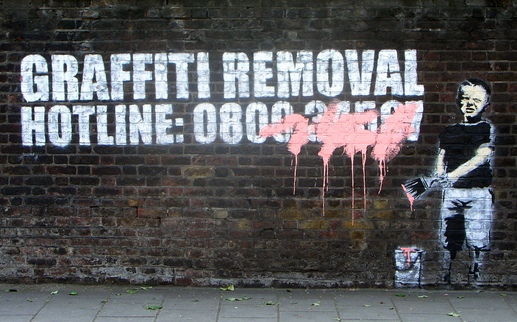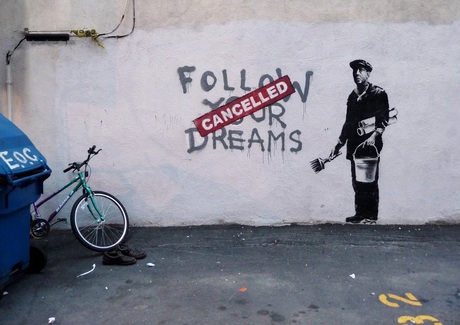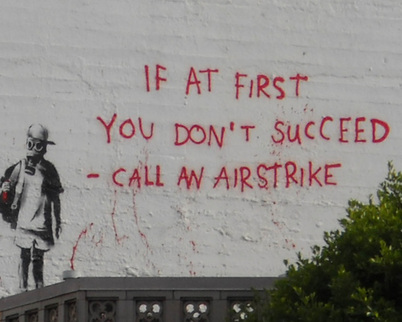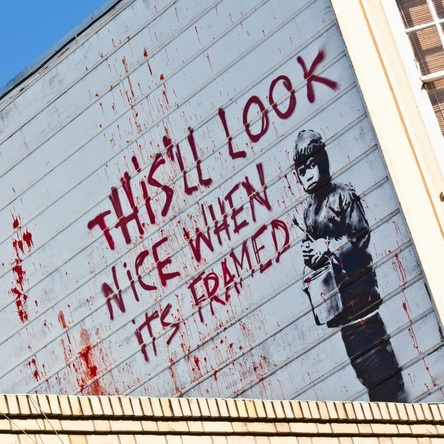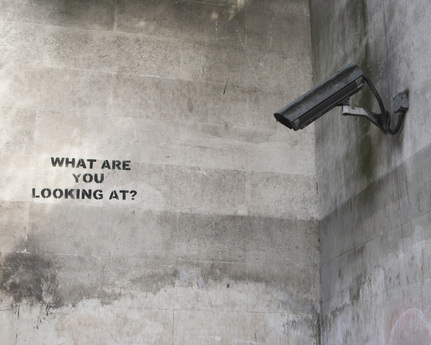Exit Through the Gift Shop:
|
|
|
Thanks to New Media, the world can view Banksy’s creations even after angered authorities have removed them. His art freely networks around the globe, inspiring many with its messages. Fellow street artist Blek le Rat, who inspired Banksy’s frequent use of rat images, comments that a rat is “the only free animal in the city” and one which “spreads plague everywhere, just like street art.” Because we are able to digitally immortalize this art and effortlessly expose it to countless people, street art truly does spread like the plague. Banksy says of rats, “They exist without permission. They are hated, hunted, and persecuted… if you are dirty, insignificant, and unloved, then rats are the ultimate role model.” This concept of existing without permission reflects Banksy’s belief in existentialism (or “existencilism”), which holds that existence precedes essence and one must be true to his or her own spirit. The only meaning life has is the one we give it, which is why Banksy feels compelled to give his own meaning to his surroundings, even if it is illegal to do so. With the view that we should be true to ourselves despite the world’s disapproval, artists like those depicted in Exit through the Gift Shop, even Mr. Brainwash, give meaning to their existence through brave rebellion which is now displayed to the world.
Carissa Collins: The Grand Debut of Street Art: An Underground Culture Tarnished
In Banksy’s 2010 film, Exit Through the Gift Shop, the renowned street artist allows the audience to experience the interworking of the underground street art culture. Part of the allure of film is the visibility it gives to the underground street art culture: the mysteriousness, the shadows, the secrecy, the illegality, and the pseudonyms. Audiences tap into a realm that is unknown or, at most, only whispered about. Exit Through the Gift Shop not only explores the draw of the underground culture but also how easily it can be tainted with fame and exposure in the mainstream. It takes very little for an underground movement to be spoiled and, like photos being processed in a darkroom, the art of the underground is damaged once it is brought into the light.
In Banksy’s 2010 film, Exit Through the Gift Shop, the renowned street artist allows the audience to experience the interworking of the underground street art culture. Part of the allure of film is the visibility it gives to the underground street art culture: the mysteriousness, the shadows, the secrecy, the illegality, and the pseudonyms. Audiences tap into a realm that is unknown or, at most, only whispered about. Exit Through the Gift Shop not only explores the draw of the underground culture but also how easily it can be tainted with fame and exposure in the mainstream. It takes very little for an underground movement to be spoiled and, like photos being processed in a darkroom, the art of the underground is damaged once it is brought into the light.
It is crucial to understand what is so very “underground” about Banksy-era street art. The most popular definition of “underground” on Urbandictionary.com is “a genre in music and other forms of media intended for an elite audience, that is often characterized by its high levels of originality and experimentation, and does not conform to typical standards, trends, or hypes as set by the popular mainstream media” (Urbandictionary.com). Banksy-era street art is a fantastic example of this underground culture. Banksy began free handing and stenciling in the early 1990s when street art had extremely minimal exposure and mainstream acceptance. The street artist spent a large part of his career out of the limelight and out of the sunlight. His work was politically controversial, sometimes bawdy, and in a medium that skirted illegality. These characteristics, as well as Banksy’s mysterious identity, joined to create a perfect masterpiece of underground culture. By the mid 2000’s, Banksy’s work was selling for thousands and found homes in the collections of art aficionados. However, Banksy’s goal was never to become popular. Indeed, the acceptance of Banksy’s politically charged graffiti is extremely ironic in light of the traditional standards of art.
Yet, two events would soon distort Banksy’s and his fellow street artist’s underground identity. The premiere of Exit Through the Gift Shop (which was also underground in its marketing and release) and the rise of Mr. Brainwash, Thierry’s street artist alias, drastically changed the core of underground street art. While he rose to fame, Banksy walked a fine line between the underground and the mainstream. He tactfully maintained his underground flavor while putting on massive art shows for his work. Then Thierry was accepted into the underground community. He enjoyed the thrill of nighttime vandalism as well as the acceptance from the famed underground artists. Yet, for whatever reason, Thierry never seemed to be content with what he has. Thierry too hoped to join in on the making of street art. While underground culture is all about being nontraditional, Thierry seemed to take that a step further by going against the nontraditional culture. Instead of humble and secretive beginnings, Thierry turned his art project into a massive, assembly-lined, colossally advertised spectacle. He made a name for himself out of nothing but hype. His “street art” was acclaimed across much of traditional media. According to Banksy in the film, “Most artists take years to develop their style. Thierry seemed to miss out on all those bits.” However, to quote Banksy again, it is likely he did not say this “in a good way.”
Some believe that this film was indeed the first street art disaster film. Mr. Brainwash’s manipulation of the underground aura pulled long-preserved quirks and treasures into the blinding sunlight. On one hand, there are more street art appreciators in the world because of Thierry’s career and the success of Exit Through the Gift Shop. On the other hand, the original oddity and appeal of underground street art has been irrevocable tainted.
Some believe that this film was indeed the first street art disaster film. Mr. Brainwash’s manipulation of the underground aura pulled long-preserved quirks and treasures into the blinding sunlight. On one hand, there are more street art appreciators in the world because of Thierry’s career and the success of Exit Through the Gift Shop. On the other hand, the original oddity and appeal of underground street art has been irrevocable tainted.
Today, underground culture includes both the experiential culture of the future, such as the posthuman technological discovery, as well as the notorious “hipster” culture of the retro. Neither of these extremes embraces the present, as one rockets into the future and the other reminisces for the past. It seems strange that the photo-filtering application Facebook bought for $1 billion does not create cutting-edge, futuristic photos. Rather, the top photo-filtering application for our smartphones makes photos looks… old. However, it seems that retro is the way to go for people displeased with the mainstream. This attachment to things of past decades is also palpable in the fashion industry, as seen by Kurt Andersen of Vanity Fair. In January of 2012, he wrote that the fashion industry is experiencing a “devolution,” where popular style is stuck on repeat. He hopes for a style revolution to break fashion out of this cycle of horn-rimmed glasses and Dr. Martens. However, Andersen fears that Western culture may die with a “long, nostalgic whimper” (Andersen 3).
The exploitation of street art and the underground by Mr. Brainwash brings us to the intriguing and vicious relationship between underground and the mainstream cultures. The allure of the underground is the inability to describe what it actually includes and entails. Not only are the parameters of underground culture hazy, but the central nature and identity of the underground itself is unclear as well. It is debated whether the underground is precisely the exact antithesis of the mainstream, and thus relies heavily on what the mainstream is currently accepting and not accepting, or if the underground is the ignorance of the mainstream. Even though it would seem that Banksy would err on the side of not caring one mite about the mainstream, he felt regretful about having launched Mr. Brainwash (and possibly the world of street art) into the spotlight. At the end of the film’s interviewing, he says, “I used to encourage everyone I knew to make art; I don't do that so much anymore.”
Therefore, because of the New Media impact, the underground culture finds itself in a new phase. The introduction of invasive new media technology has fully ensured the dusk of traditional underground culture as we knew it. The question we must now ask our selves if underground culture has simply morphed because of New Media or if it even exists. Every person with a smartphone is a journalist able to publish visual and textual information instantly. Does New Media allow too many people to join in on an underground movement, without proper induction by others? Depending on your definition of underground culture, the marvel of the 90’s may be forever in the past.
Therefore, because of the New Media impact, the underground culture finds itself in a new phase. The introduction of invasive new media technology has fully ensured the dusk of traditional underground culture as we knew it. The question we must now ask our selves if underground culture has simply morphed because of New Media or if it even exists. Every person with a smartphone is a journalist able to publish visual and textual information instantly. Does New Media allow too many people to join in on an underground movement, without proper induction by others? Depending on your definition of underground culture, the marvel of the 90’s may be forever in the past.
While the overall future of the underground is debatable, the premiere of Exit Though the Gift Shop certainly marked the end of a chapter in street art. For one, Mr. Brainwash had fully and thoroughly exploited street art through his assembly-line style of art creation and position in mainstream media. Secondly, the film itself undermined the underground nature of street art through its popularity. It seems grossly ironic that Banksy, king of the underground, should be the one to thrust his shadowy kingdom into the spotlight. Perhaps he wanted to have the last word. If the thing he birthed was dying, he wanted to be the one to kill it. And yet, it seems there is still room for Banksy to beat this dead horse. Don’t forget to mark your calendars for the debut of Banksy’s new book, set to hit shelves this summer at a bookstore near you.
Works Cited
- “Underground.” Urban Dictionary. Urban Dictionary, 2005. Web. 2 May. 2012
- Exit Through the Gift Shop. Dir. Banksy. Paranoid Pictures, 2010. Film.
- Andersen, Kurt. “You Say You Want a Devolution?” Vanityfair.com. Vanity Fair Worldwide, Jan. 2012. Web. 2 May. 2012.

